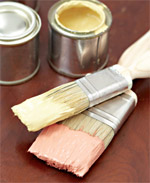
Paintbrushes
The difference between an expensive paintbrush
and a cheaper one generally lies in the quality
and quantity of its bristles. A good paintbrush has
dense, straight bristles that are securely attached
to the handle. Where they meet the handle, the
bristles are thick, tapering to a sharp edge.
A good paintbrush is more durable, less likely
to drip or mess, offers better control, and you can
apply paint in neat strokes without the bristles
straying or shedding.
Standard paintbrushes are available in 12mm to 150mm sizes. Choose the size of the brush based on how big a surface you need to paint. Never try to paint a large surface area with a small brush. It will not only take you longer, but it will also be difficult to achieve a neat finish.
Larger and special paintbrushes are specially designed for certain jobs. New on the market is a range of paintbrushes that make it easier to paint large surfaces. There are brushes for tiled roofs and curved roofing sheets, floors and walls. They are more expensive, but they make the job a lot easier. Also very handy is the radiator brush, a long-handled brush with an angled head, which gets to difficult-to-reach places such as behind a gutter or inside kitchen cupboards. A cheaper solution for large surfaces is the standard cement brush, which is actually designed for building purposes, but works well if a neat finish is not that important − when lime-washing walls, for example.
Rollers
Rollers are generally available in extracoarse,
coarse, fine and extra-fine
versions. For oil-based paints, there are
special fine and extra-fine rollers to help
you achieve a smooth finish. For waterbased
paints, the following special rollers
are available:
Extra-coarse sheepskin rollers are
durable rollers that give a good finish on
coarse surfaces such as cement walls.
Extra-coarse synthetic rollers are more
durable than sheepskin ones, and easier
to clean, but they don't hold paint as well.
Inexpensive extra-coarse rollers can
be used for very coarse surfaces where a
neat finish is not essential, such as rough
concrete and damaged steel and plates.
However, these rollers are inclined to shed
fibres and are not durable enough for
repeated use.
There are also smaller rollers available
in 50mm to 160mm sizes. They are
available in micro fibre and sponge.
Micro-fibre rollers are used when
you want to achieve a neat finish when
working with oil-based paints.
Sponge rollers are probably the
handiest piece of painting equipment
currently on the market. They are suitable
for oil- and water-based paints and offer
superb paint retention. With a bit of
practice, you can also achieve a good
finish. Sponge rollers are faster and easier
to work with than paintbrushes. The only
drawbacks are that they cannot reach
corners and are difficult to clean when
using oil-based paint.
Pic: Jan Ras for Woman's Value




 Publications
Publications
 Partners
Partners









